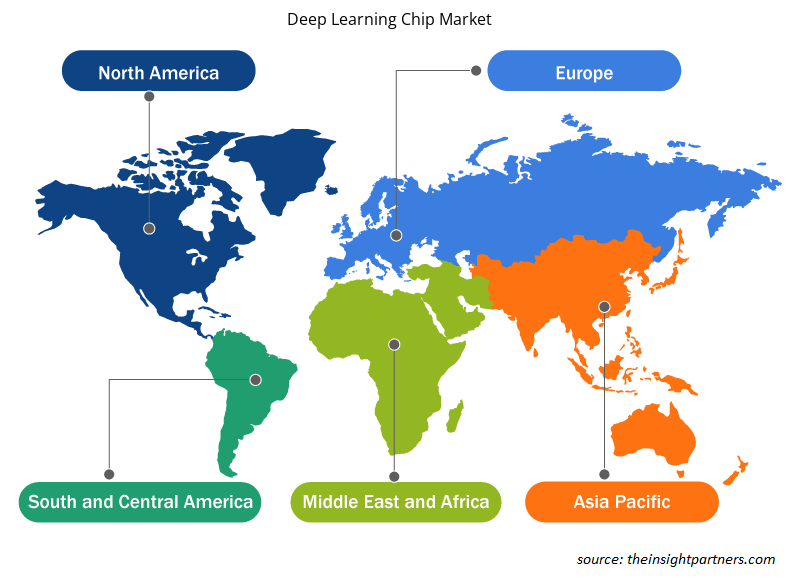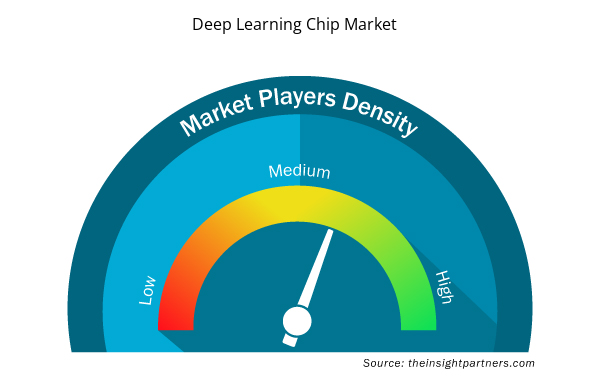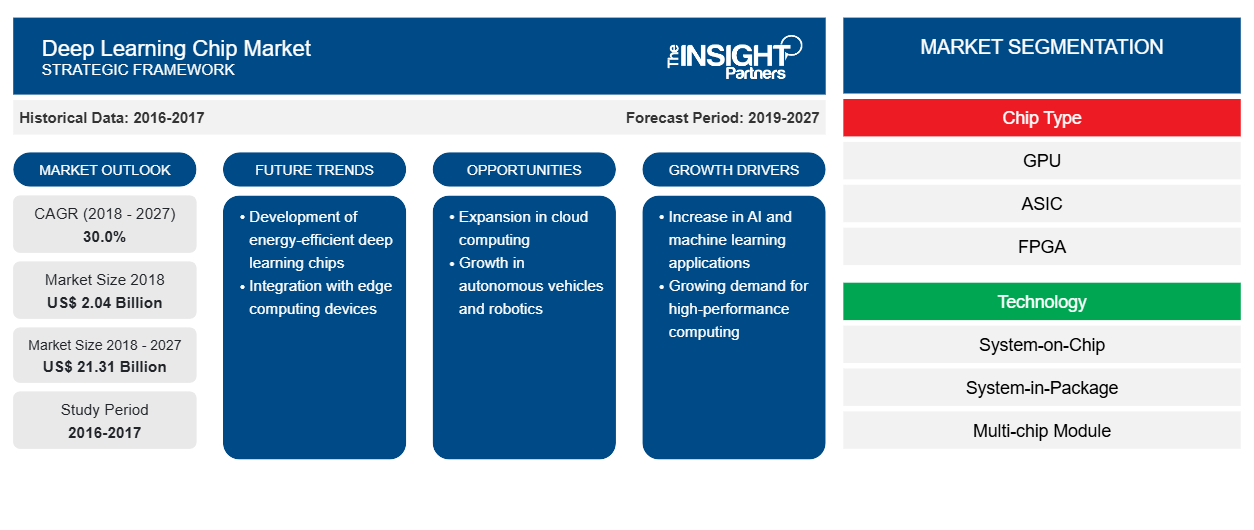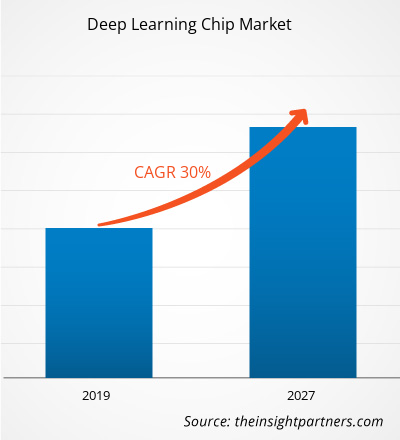El mercado global de chips de aprendizaje profundo representó US$ 2.04 mil millones en 2018 y se espera que crezca a una CAGR del 30,0 % durante el período de pronóstico 2019-2027, para alcanzar US$ 21.31 mil millones en 2027.
América del Norte lidera el mercado mundial de chips de aprendizaje profundo y se prevé que sea el mayor contribuyente a los ingresos durante el período de pronóstico. El desarrollo de chips de aprendizaje profundo está respaldado por una inversión a gran escala de gigantes tecnológicos para desarrollar patrones a partir de una enorme cantidad de datos generados. El auge de la computación cuántica y la implementación de chips de aprendizaje profundo en robótica están impulsando el crecimiento del mercado de chips de aprendizaje profundo en los países de América del Norte.
Perspectivas del mercado
La importancia de la computación cuántica contribuye al crecimiento del mercado de chips de aprendizaje profundo
La computación cuántica tarda segundos en finalizar un cálculo que de otro modo llevaría más tiempo. Las computadoras cuánticas son una transformación innovadora de la inteligencia artificial, el aprendizaje automático y el big data. Por lo tanto, se espera que la importancia de la computación cuántica impulse el crecimiento del mercado de chips de aprendizaje profundo. Además, la computación cuántica es beneficiosa para varios factores, entre ellos la optimización de la cartera, la detección de fraudes y la gestión de riesgos, y las áreas en las que se requiere una retroalimentación de datos inmediata. Por lo tanto, es más fácil para un solo procesador realizar cálculos complejos en segundos. Además, con la escala y el tamaño de Internet , el aprendizaje profundo ayuda a mantener grandes conjuntos de datos a un costo muy bajo. Por lo tanto, se espera que estos factores impulsen el crecimiento del mercado global de chips de aprendizaje profundo.
Personalice este informe según sus necesidades
Obtendrá personalización en cualquier informe, sin cargo, incluidas partes de este informe o análisis a nivel de país, paquete de datos de Excel, así como también grandes ofertas y descuentos para empresas emergentes y universidades.
- Obtenga las principales tendencias clave del mercado de este informe.Esta muestra GRATUITA incluirá análisis de datos, desde tendencias del mercado hasta estimaciones y pronósticos.
Información sobre el comportamiento del consumidor en tiempo real y mayor eficiencia operativa para impulsar el crecimiento general del mercado de chips de aprendizaje profundo
La naturaleza de los negocios se está volviendo muy competitiva y, para competir de manera eficiente, las empresas hoy en día dependen de información útil y de análisis de negocios. Tradicionalmente, las herramientas de análisis de negocios se utilizaban para proyectar las ventas a partir de los datos sobre eventos que tenían una semana o un mes de antigüedad. Con la llegada de la tecnología de inteligencia artificial, que aprende en tiempo real y brinda recomendaciones basadas en patrones, las empresas tienen una gran oportunidad de aplicar el aprendizaje profundo en diversos procesos para comprender mejor el entorno empresarial y a los clientes.
Considerando estos factores, la inteligencia artificial permite a las empresas mejorar la eficiencia operativa, reducir los costos operativos, mejorar la calidad del servicio y la experiencia del cliente.
Información sobre los tipos de chips
Las unidades de procesamiento gráfico (GPU) tuvieron la mayor participación en el mercado de chips de aprendizaje profundo en 2018, mientras que se espera que los circuitos integrados específicos para aplicaciones (ASIC) sean el segmento de más rápido crecimiento durante el período de pronóstico. Esto se debe a que los ASIC son muy específicos y menos flexibles, pero son una de las opciones de hardware de mayor rendimiento disponibles para aplicaciones de inteligencia artificial.
Perspectivas tecnológicas
Los chipsets de aprendizaje profundo incluyen sistemas en chip, sistemas en paquete, módulos multichip y otros. El segmento de sistemas en chip tuvo la mayor participación en el mercado de chips de aprendizaje profundo en 2018, ya que ayuda a reducir el desperdicio de energía, el espacio ocupado por los sistemas grandes y los costos.
Perspectivas verticales de la industria
El mercado global de chips de aprendizaje profundo se clasifica en BFSI, Comercio minorista, TI y telecomunicaciones, Automoción y transporte, Salud, Medios y entretenimiento, y otros. BFSI tuvo la mayor participación de mercado en el mercado de chips de aprendizaje profundo, mientras que se espera que la atención médica sea el segmento de más rápido crecimiento en el mercado. Los factores como la reducción del costo operativo, la adaptación a los cambios en los cumplimientos y las regulaciones, el enfoque en el negocio principal y la integración de la automatización en los procesos comerciales son otros factores importantes que están impulsando el crecimiento del segmento BFSI en el mercado de chips de aprendizaje profundo.
Los actores del mercado presentes en el mercado de chips de aprendizaje profundo se centran principalmente en las mejoras de productos mediante la implementación de tecnologías avanzadas. La firma de asociaciones, contratos, empresas conjuntas, financiación e inauguración de nuevas oficinas en todo el mundo permiten a la empresa mantener su marca a nivel mundial. A continuación se enumeran algunos de los desarrollos recientes:
2019: NVIDIA se ha asociado con Hackster.io para lanzar AI at the Edge Challenge, una competencia en la que los desarrolladores utilizan el NVIDIA Jetson Nano Developer Kit para crear proyectos creativos y únicos y tener la oportunidad de ganar hasta $100 000 en premios.
2019: Intel anunció sus planes de ampliar la fábrica de Oregon para producir un chip de 7 nm. La nueva fábrica de Intel será la tercera fase de D1X, una enorme fábrica que Intel comenzó a construir en 2010. Cada una de las dos primeras fases tenía una superficie de 1,1 millones de pies cuadrados, lo que creaba unas instalaciones combinadas equivalentes a 15 almacenes Costco. La tercera fase aparentemente aumentará el espacio de fabricación de D1X en aproximadamente un 50 por ciento. Además, Intel dice que la expansión de su fábrica le permitirá responder un 60 por ciento más rápido a la escasez de chips.
2019: Huawei lanzó HiSecEngine USG12000, el primer AIFW de nivel T de la industria. HiSecEngine USG12000 está equipado con chips de inteligencia artificial Ascend, que brindan capacidades de detección inteligente, así como defensa de fronteras inteligente para redes empresariales.
Perspectivas regionales del mercado de chips de aprendizaje profundo
Los analistas de Insight Partners explicaron en detalle las tendencias y los factores regionales que influyen en el mercado de chips de aprendizaje profundo durante el período de pronóstico. Esta sección también analiza los segmentos y la geografía del mercado de chips de aprendizaje profundo en América del Norte, Europa, Asia Pacífico, Oriente Medio y África, y América del Sur y Central.

- Obtenga datos regionales específicos para el mercado de chips de aprendizaje profundo
Alcance del informe sobre el mercado de chips de aprendizaje profundo
| Atributo del informe | Detalles |
|---|---|
| Tamaño del mercado en 2018 | US$ 2.04 mil millones |
| Tamaño del mercado en 2027 | US$ 21.31 mil millones |
| Tasa de crecimiento anual compuesta (CAGR) global (2018-2027) | 30,0% |
| Datos históricos | 2016-2017 |
| Período de pronóstico | 2019-2027 |
| Segmentos cubiertos | Por tipo de chip
|
| Regiones y países cubiertos | América del norte
|
| Líderes del mercado y perfiles de empresas clave |
|
Densidad de actores del mercado: comprensión de su impacto en la dinámica empresarial
El mercado de chips de aprendizaje profundo está creciendo rápidamente, impulsado por la creciente demanda de los usuarios finales debido a factores como la evolución de las preferencias de los consumidores, los avances tecnológicos y una mayor conciencia de los beneficios del producto. A medida que aumenta la demanda, las empresas amplían sus ofertas, innovan para satisfacer las necesidades de los consumidores y aprovechan las tendencias emergentes, lo que impulsa aún más el crecimiento del mercado.
La densidad de actores del mercado se refiere a la distribución de las empresas o firmas que operan dentro de un mercado o industria en particular. Indica cuántos competidores (actores del mercado) están presentes en un espacio de mercado determinado en relación con su tamaño o valor total de mercado.
Las principales empresas que operan en el mercado de chips de aprendizaje profundo son:
- Dispositivos micro avanzados, inc.
- Alphabet Inc. (Google)
- Amazon.com, Inc.
- Compañía: Baidu, Inc.
- Huawei Technologies Co., Ltd
Descargo de responsabilidad : Las empresas enumeradas anteriormente no están clasificadas en ningún orden particular.

- Obtenga una descripción general de los principales actores clave del mercado de chips de aprendizaje profundo
SEGMENTACIÓN DEL MERCADO GLOBAL DE CHIP DE APRENDIZAJE PROFUNDO
Por tipo de chip
- GPU
- ASIC
- FPGA
- UPC
- Otros
Por tecnología
- Sistema en chip
- Sistema en paquete
- Módulo multichip
- Otros
Por sector industrial vertical
- Medios y publicidad
- BFSI, TI y telecomunicaciones
- Minorista
- Cuidado de la salud
- Automoción y transporte
- Otros
Por geografía
América del norte
- A NOSOTROS
- Canadá
- México
Europa
- Francia
- Alemania
- Reino Unido
- Rusia
- Italia
- Resto de Europa
Asia Pacífico (APAC)
- Australia
- Porcelana
- India
- Japón
- Corea del Sur
- Resto de APAC
Oriente Medio y África (MEA)
- Arabia Saudita
- Sudáfrica
- Emiratos Árabes Unidos
- Resto de MEA
América del Sur (SAM)
- Brasil
- Argentina
- Resto de SAM
Perfiles de empresas
- Dispositivos micro avanzados, inc.
- Alphabet Inc. (Google)
- Amazon.com, Inc.
- Compañía: Baidu, Inc.
- Huawei Technologies Co., Ltd
- Corporación Intel
- Corporación NVIDIA
- Qualcomm Incorporated
- Samsung Electronics Co., Ltd.
- Compañía: Xilinx, Inc.
- Análisis histórico (2 años), año base, pronóstico (7 años) con CAGR
- Análisis PEST y FODA
- Tamaño del mercado Valor/volumen: global, regional, nacional
- Industria y panorama competitivo
- Conjunto de datos de Excel



Report Coverage
Revenue forecast, Company Analysis, Industry landscape, Growth factors, and Trends

Segment Covered
This text is related
to segments covered.

Regional Scope
North America, Europe, Asia Pacific, Middle East & Africa, South & Central America

Country Scope
This text is related
to country scope.
Preguntas frecuentes
The BFSI industry dominated the deep learning chip market in the year 2018. Banking, financial services, and insurance (BFSI) industries have great potential for deep learning chips due to the presence of huge financial and personal data of customers. In this sector, a high amount of sensitive data is generated and exchanged every day. There is growing volume and creation of endpoints and mobile devices in banks, credit card companies, and credit reporting institutions, thus, it becomes important for these industry verticals to harness this data to gain insights about various business aspects.
Presently, the major applications of deep learning chips are in the data center/cloud computing segment, and this trend is expected to continue during the forecast period. Also, majorly due to rising adoption of AI in developing regions, evolving architectures of deep learning chips and increasing applications across various industry verticals. Owing to this growing trend, the companies are anticipated to produce high-quality service by adopting cloud-based artificial intelligence services.
North America is one of the fastest-growing regions in terms of technological development. In the past 3 years, the region witnessed significant adoption of AI solutions across all the sectors. North America contributes the largest market share in terms of revenue, and it is estimated that it will continue its dominance in the market share during the forecast period. Deep learning chip development is backed by large-scale investment from technological giants to develop patterns from huge amount of generated data. The rise of quantum computing and implementation of deep learning chips in robotics drive the growth of the deep learning chip market in the North American countries.
Trends and growth analysis reports related to Electronics and Semiconductor : READ MORE..
The List of Companies - Deep Learning Chip Market
- Advanced Micro Devices, Inc.
- Alphabet Inc. (Google)
- Amazon.com, Inc.
- Baidu, Inc.
- Huawei Technologies Co., Ltd
- Intel Corporation
- NVIDIA Corporation
- Qualcomm Incorporated
- Samsung Electronics Co., Ltd.
- Xilinx, Inc.
The Insight Partners performs research in 4 major stages: Data Collection & Secondary Research, Primary Research, Data Analysis and Data Triangulation & Final Review.
- Data Collection and Secondary Research:
As a market research and consulting firm operating from a decade, we have published and advised several client across the globe. First step for any study will start with an assessment of currently available data and insights from existing reports. Further, historical and current market information is collected from Investor Presentations, Annual Reports, SEC Filings, etc., and other information related to company’s performance and market positioning are gathered from Paid Databases (Factiva, Hoovers, and Reuters) and various other publications available in public domain.
Several associations trade associates, technical forums, institutes, societies and organization are accessed to gain technical as well as market related insights through their publications such as research papers, blogs and press releases related to the studies are referred to get cues about the market. Further, white papers, journals, magazines, and other news articles published in last 3 years are scrutinized and analyzed to understand the current market trends.
- Primary Research:
The primarily interview analysis comprise of data obtained from industry participants interview and answers to survey questions gathered by in-house primary team.
For primary research, interviews are conducted with industry experts/CEOs/Marketing Managers/VPs/Subject Matter Experts from both demand and supply side to get a 360-degree view of the market. The primary team conducts several interviews based on the complexity of the markets to understand the various market trends and dynamics which makes research more credible and precise.
A typical research interview fulfils the following functions:
- Provides first-hand information on the market size, market trends, growth trends, competitive landscape, and outlook
- Validates and strengthens in-house secondary research findings
- Develops the analysis team’s expertise and market understanding
Primary research involves email interactions and telephone interviews for each market, category, segment, and sub-segment across geographies. The participants who typically take part in such a process include, but are not limited to:
- Industry participants: VPs, business development managers, market intelligence managers and national sales managers
- Outside experts: Valuation experts, research analysts and key opinion leaders specializing in the electronics and semiconductor industry.
Below is the breakup of our primary respondents by company, designation, and region:

Once we receive the confirmation from primary research sources or primary respondents, we finalize the base year market estimation and forecast the data as per the macroeconomic and microeconomic factors assessed during data collection.
- Data Analysis:
Once data is validated through both secondary as well as primary respondents, we finalize the market estimations by hypothesis formulation and factor analysis at regional and country level.
- Macro-Economic Factor Analysis:
We analyse macroeconomic indicators such the gross domestic product (GDP), increase in the demand for goods and services across industries, technological advancement, regional economic growth, governmental policies, the influence of COVID-19, PEST analysis, and other aspects. This analysis aids in setting benchmarks for various nations/regions and approximating market splits. Additionally, the general trend of the aforementioned components aid in determining the market's development possibilities.
- Country Level Data:
Various factors that are especially aligned to the country are taken into account to determine the market size for a certain area and country, including the presence of vendors, such as headquarters and offices, the country's GDP, demand patterns, and industry growth. To comprehend the market dynamics for the nation, a number of growth variables, inhibitors, application areas, and current market trends are researched. The aforementioned elements aid in determining the country's overall market's growth potential.
- Company Profile:
The “Table of Contents” is formulated by listing and analyzing more than 25 - 30 companies operating in the market ecosystem across geographies. However, we profile only 10 companies as a standard practice in our syndicate reports. These 10 companies comprise leading, emerging, and regional players. Nonetheless, our analysis is not restricted to the 10 listed companies, we also analyze other companies present in the market to develop a holistic view and understand the prevailing trends. The “Company Profiles” section in the report covers key facts, business description, products & services, financial information, SWOT analysis, and key developments. The financial information presented is extracted from the annual reports and official documents of the publicly listed companies. Upon collecting the information for the sections of respective companies, we verify them via various primary sources and then compile the data in respective company profiles. The company level information helps us in deriving the base number as well as in forecasting the market size.
- Developing Base Number:
Aggregation of sales statistics (2020-2022) and macro-economic factor, and other secondary and primary research insights are utilized to arrive at base number and related market shares for 2022. The data gaps are identified in this step and relevant market data is analyzed, collected from paid primary interviews or databases. On finalizing the base year market size, forecasts are developed on the basis of macro-economic, industry and market growth factors and company level analysis.
- Data Triangulation and Final Review:
The market findings and base year market size calculations are validated from supply as well as demand side. Demand side validations are based on macro-economic factor analysis and benchmarks for respective regions and countries. In case of supply side validations, revenues of major companies are estimated (in case not available) based on industry benchmark, approximate number of employees, product portfolio, and primary interviews revenues are gathered. Further revenue from target product/service segment is assessed to avoid overshooting of market statistics. In case of heavy deviations between supply and demand side values, all thes steps are repeated to achieve synchronization.
We follow an iterative model, wherein we share our research findings with Subject Matter Experts (SME’s) and Key Opinion Leaders (KOLs) until consensus view of the market is not formulated – this model negates any drastic deviation in the opinions of experts. Only validated and universally acceptable research findings are quoted in our reports.
We have important check points that we use to validate our research findings – which we call – data triangulation, where we validate the information, we generate from secondary sources with primary interviews and then we re-validate with our internal data bases and Subject matter experts. This comprehensive model enables us to deliver high quality, reliable data in shortest possible time.


 Obtenga una muestra gratuita de este informe
Obtenga una muestra gratuita de este informe